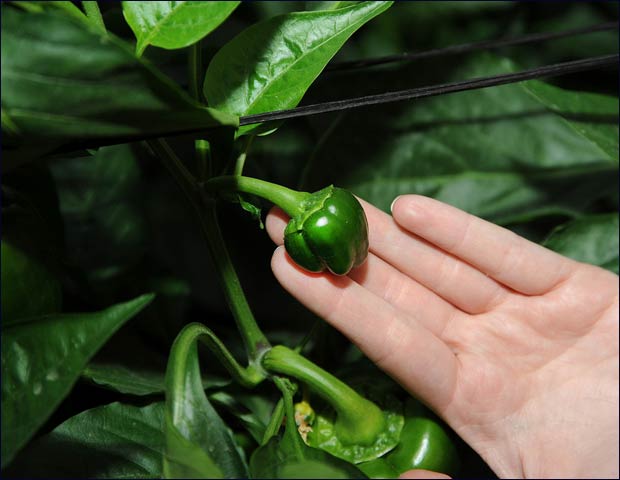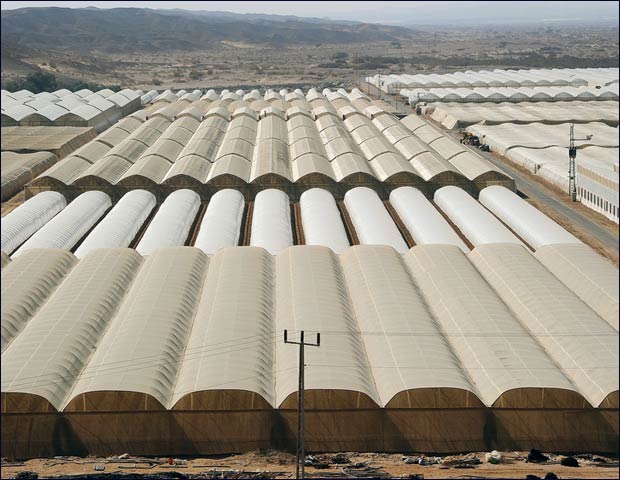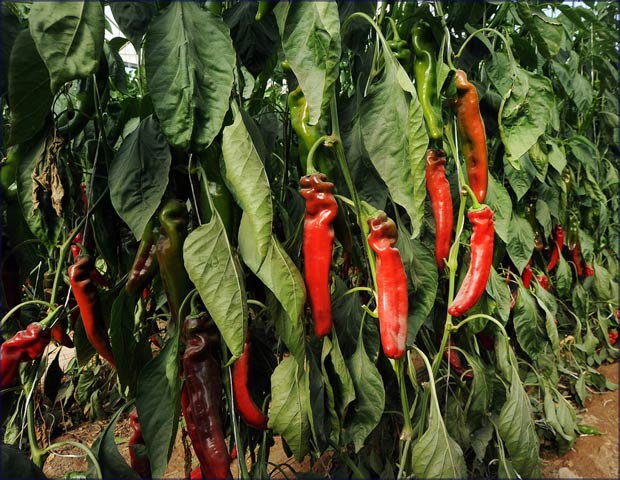By Avigayil Kadesh
Back in 1959, a bunch of idealistic would-be farmers staked a claim in the arid sands of Israel’s Arava, a quite literally deserted region situated along 180 kilometers (about 112 miles) stretching from the Dead Sea in the north to the southern city of Eilat on the Red Sea coast.
Sure, the narrow strip of land offered picturesque landscapes winding from the mountains of the Negev highlands in the west to the Edom mountains of Jordan in the east. But farmland? Not likely.
“You couldn’t live in the Arava, let alone grow vegetables there,” says Gadiel.
Today, however, thriving Arava farms supply more than 60 percent of total Israeli exports of fresh vegetables and about 10% of ornamental exports such as flowers and exotic fish.
Turns out these early pioneers, so eager to fulfill David Ben-Gurion’s vision of a blooming desert, weren’t so crazy after all. The kibbutzim they established – Yotvata, Ein Yahav, Ein Gedi – are still around as proof that anything is possible with enough human ingenuity and a little help from above.
The drip works wonders
Gadiel explains that
modern drip irrigation, innovated in the early 1960s in Israel, was the number one advancement that allowed the experiment to succeed.
Until that time, agriculture in Israel was almost entirely dependent on rainfall, and therefore was limited to the northern and coastal sections of the country.
“Some of the pioneers of drip irrigation, such as Simcha Blass and Yuval Zohar, made Israel as a whole an example for the entire world,” he says. “Israel has always shared [its expertise]. People come from abroad to see cotton, vegetables and date trees growing on drip irrigation. In the last 15 years, the Arava in particular has become an international school for agricultural trainees.”
In drip irrigation, which Israel’s agricultural researchers are constantly improving and refining, water is dripped uniformly onto the root system of crops from a specially constructed pipe. Both water and fertilizers can be delivered economically in quantities to fit any soil type, and even poorer quality saline water can be used effectively.
Because agriculture gobbles up the largest portion of available water, this efficiency is especially important in a country that gets rain only during the winter months. The United Nations chose the Arava region as a global model for agricultural education on using minimal water.

Baby peppers at Yair Experimental Station
What drip irrigation started, Arava R&D has continued through unique cooperative programs that demonstrate what can happen through sharing collective wisdom.
“We try to work with the growers and agricultural extension services and commercial companies like seed companies, because they are all here in the Arava. We use our website and we have seminars and tours for growers. We try to get the knowledge flowing back and forth,” says Gadiel.
Many hands make successful work
Arava R&D was established in 1986 to serve the development needs of farmers in officially declared high-priority periphery areas. The Jewish Agency supported the venture until 1997, when the Jewish National Fund took over in conjunction with the Ministry of Agriculture and Rural Development and its Volcani Agricultural Research Organization, along with other government agencies, regional councils and private sponsors.
Many different projects are ongoing today in seven agricultural villages of the central and northern Arava – Neot HaKikar, Ein Tamar, Paran, Idan, Hatzeva, Ein Yahav and Tzofar -- and Ein Hatzeva, a private farm. This amounts to about 35,000 dunams (8,650 acres) of vegetables and flowers raised protectively in greenhouses, shade houses and walk-in plastic tunnels innovated in Israel.

Greenhouses in Moshav Hatzeva
Two experimental stations -- Yair Station near Hatzeva and Zohar Station near Neot HaKikar -- serve as ground-zero for cutting-edge research initiatives focused on vegetables, ornamentals, plant protection, orchards, organic agriculture, fishery and quality assurance.
Regularly scheduled site tours, plus online forums, acquaint researchers, scientists and about 600 farmers with one another’s advances and challenges, says Gadiel.
“You can see what the growers are doing, and they can see what you think could help. Some farmer may be trying something new and we will go test it on an academic level,” he explains. “The interaction is ongoing and constant between all the parties, but it’s not so easy to accomplish.”
This year, because the Arava has absorbed many new farmers, a public course was organized to teach about all aspects of basic agriculture, says Gadiel. Instructors from the agricultural extension service, Arava R&D, business and academia are covering topics including the most updated methods of irrigation and plant protection.
“We sponsor meetings with R&D people so that they will get to know the farmers and discuss new options in growing,” adds Gadiel. “We’re testing all kinds of things: Our farmers are growing more and more dates, mangos and table grapes and raising ornamental fish, though this is going slowly.”
Two other examples of current Arava R&D projects include developing hardier seed varieties in cooperation with seed companies; and finding an entirely new type of plastic covering for greenhouses.
The new solar-warmed hothouse at the Yair Experimental Station
Gadiel explains why the material of the covering is such a crucial concern: “Because of the high price of energy, conventional methods of heating greenhouses are too expensive, so we are testing a new system that will enable us to save about 70-80% of the cost of the energy now used for heating greenhouses,” he says. “It’s even possible that a new plastic would make enough of a difference so growers would not have to use heating at all.”
Exporting know-how and good will
The flow of expertise goes way beyond the borders of the Arava.
“We have a lot of students coming here for year-long projects to study and work with families of Arava farmers -- mainly from Thailand, Myanmar and other Far East countries, in cooperation with the Foreign Ministry,” Gadiel relates. “When they go back home, each student becomes an ambassador for Israel.”
In addition, experts from Arava R&D travel abroad to give practical courses through MASHAV, Israel’s Agency for International Development Cooperation.
“One of my students went to Ethiopia to teach farmers about vegetable farming and irrigation, and she goes back every now and then to follow up,” says Gadiel.
“I think Israeli agriculture in general is an example for the whole world of how you can develop an area and live in it, too. This is one part of the equation. The other part is that, in the last decade or more, we have managed to develop the agriculture mainly of vegetables but also of flowers and dates for export. We learned how to use our advantages, especially in winter, to produce good-quality vegetables for export to Europe and the United States.”
This is a tough market to compete in, because growers from many other countries are increasingly vying for the same customers.
So it’s critical to keep searching for the best-yielding plants at the lowest cost. Traditionally, dozens of varieties of peppers have been the strongest crop in the Arava.

Peppers growing in the Arava
“Peppers grow well here,” says Gadiel. “They like the weather and they require less labor. We have good quality produce to send to Europe in the winter. In the long run, it’s a good crop.”
Next up: strawberries and apricots
Arava farms – 15% of which are organic, while the rest use reduced pesticide levels -- also produce tomatoes, cherry tomatoes, eggplants, melons, watermelons, table grapes, herbs and dates for export, making up 60% of the total Israeli exports of these agricultural crops. The remaining 40% is grown in the Negev Desert and the Jordan Valley.
Gadiel says the next promising crop is strawberries. “They cannot grow in saline water, so we’re trying to grow them with desalinated water from a small plant we have in our Yair Experimental Station. We are developing a protocol for that, and we hope we will have good quality water in a couple of years.”

Hothouse strawberry plants at Yair Experimental Station
Arava R&D has also developed a hardy variety of fig tree and a less odiferous guava fruit. “We’re trying apricots now, and we developed a protocol for organic table grapes,” Gadiel says.
Marketing these advances is another story altogether. “We have to compete with other growers and with the rate of exchange,” he says. For example, Arava figs originally sold in England for nine shekels per kilo, but now they fetch less than six because of the slipping American dollar. “Even with peppers we feel the difference,” he says.
However, the forecast is rosy for initiatives like the Clean Arava Project. One of its two components uses airplanes to disperse sterilized male fruit flies to prevent the establishment of fruit fly colonies. This allows the Arava farmers to export their produce to countries including the United States.
The other Clean Arava component requires growers to sanitize their fields for one month every summer, effectively killing off insects and viruses. “Insects move diseases from plant to plant,” Gadiel explains. “If the plants don’t exist for more than a month, then insects cannot carry disease. Then you can start the new season fresh.”
Last February, Arava R&D hosted its 21st annual Arava Open Day Exhibition, the largest agriculture expo in Israel, attracting 30,000 visitors and 200 companies over two days. The next expo is scheduled for January 23-24, 2013.
Photos by Eyal Izhar